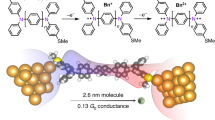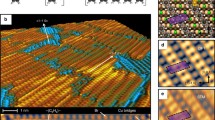Abstract
For the realization of molecular electronics, one essential goal is the ability to systematically fabricate molecular functional components in a well-controlled manner. Experimental techniques have been developed such that π-stacked ethylbenzene molecules can now be routinely induced to self-assemble on an H-terminated Si(100) surface at precise locations and along precise directions. Electron transport calculations predict that such molecular wires could indeed carry an electrical current, but the Si substrate may play a considerable role as a competing pathway for conducting electrons. In this work, we investigate the effect of placing substituent groups of varying electron donating or withdrawing strengths on the ethylbenzene molecules to determine how they would affect the transport properties of such molecular wires. The systems consist of a line of π-stacked ethylbenzene molecules covalently bonded to a Si substrate. The ethylbenzene line is bridging two Al electrodes to model current through the molecular stack. For our transport calculations, we employ a first-principles technique where density functional theory (DFT) is used within the non-equilibrium Green’s function formalism (NEGF). The calculated density of states suggest that substituent groups are an effective way to shift molecular states relative to the electronic states associated with the Si substrate. The electron transmission spectra obtained from the NEGF–DFT calculations reveal that the transport properties could also be extensively modulated by changing substituent groups. For certain molecules, it is possible to have a transmission peak at the Fermi level of the electrodes, corresponding to high conduction through the molecular wire with essentially no leakage into the Si substrate.







Similar content being viewed by others
Notes
The van der Waals radius cutoff was set to 15.0 Å, so that the terms corresponding to interactions over distances greater than this value are assumed to be zero.
The reason these levels have finite broadening is because of the π-stacking interaction with molecules in neighboring images of the periodic system.
Note that the effect of including the Si substrate is to shift the positions of the transmission peaks by ca. 0.5 eV and they become split due to hybridization with the Si states.
Comparing the transmission peak positions in Fig. 5b to the PDOS positions in Fig. 4e, we see that they differ. This is because in position of the DOS peaks are relative to the Si substrate, while in the transmission spectrum they are relative to the E F of the Al electrodes. In other words, the peaks in the transmission spectra are shifted (by ca. −1.5 eV) relative to the PDOS plots.
References
Lopinski GP, Wayner DDM, Wolkow RA (2000) Nature 406(6791):48
Piva PG, DiLabio GA, Pitters JL, Zikovsky J, Rezeq M, Dogel S, Hofer WA, Wolkow RA (2005) Nature 435(7042):658
Basu R, Guisinger NP, Greene ME, Hersam MC (2004) Appl Phys Lett 85(13):2619
Hossain MZ, Kato HS, Kawai M (2005) J Am Chem Soc 127(43):15030
Hossain MZ, Kato HS, Kawai M (2005) J Phys Chem B 109(49):23129
Zikovsky J, Dogel SA, Haider MB, DiLabio GA, Wolkow RA (2007) J Phys Chem A 111(49):12257
Kirczenow G, Piva PG, Wolkow RA (2005) Phys Rev B 72(24):245306
Liu XY, Raynolds JE, Wells C, Welch J, Cale TS (2005) J Appl Phys 98(3):033712
Rochefort A, Boyer P, Nacer B (2007) Org Elect 8(1):1
Geng WT, Oda M, Nara J, Kondo H, Ohno T (2008) J Phys Chem B 112(10):2795
Smeu M, Wolkow RA, Guo H (2009) J Am Chem Soc 131(31):11019
Kirczenow G, Piva PG, Wolkow RA (2009) Phys Rev B 80(3):035309
Venkataraman L, Park YS, Whalley AC, Nuckolls C, Hybertsen MS, Steigerwald ML (2007) Nano Lett 7(2):502
Smeu M, Wolkow RA, DiLabio GA (2008) J Chem Phys 129(3):034707
Jalili S, Ashrafi R (2011) Physica E 43(4):960
Anagaw AY, Wolkow RA, DiLabio GA (2008) J Phys Chem C 112(10):3780
Kresse G, Hafner J (1993) Phys Rev B 47(1):558
Kresse G, Furthmüller J (1996) Phys Rev B 54(16):11169
Perdew JP, Burke K, Ernzerhof M (1996) Phys Rev Lett 77(18):3865
Grimme S (2006) J Comput Chem 27(15):1787
Blöchl PE (1994) Phys Rev B 50(24):17953
Kresse G, Joubert D (1999) Phys Rev B 59(3):1758
Taylor J, Guo H, J. Wang (2001) Phys Rev B 63(24):245407
Waldron D, Haney P, Larade B, MacDonald A, Guo H (2006) Phys Rev Lett 96(16):166804
Datta S (1995) Electronic transport in mesoscopic systems. Cambridge University Press, Cambridge
Sancho MPL, Sancho JML, Rubio J (1984) J Phys F: Met Phys 14(5):1205
Troullier N, Martins JL (1991) Phys Rev B 43(3):1993
Smeu M, DiLabio GA (2010) J Phys Chem C 114(41):17874
Acknowledgments
We thank Dr. Gino A. DiLabio for numerous helpful discussions. We are grateful to Sharcnet for access to computational resources and NSERC for financial support.
Author information
Authors and Affiliations
Corresponding author
Additional information
Published as part of the special collection of articles celebrating the 50th anniversary of Theoretical Chemistry Accounts/Theoretica Chimica Acta.
Rights and permissions
About this article
Cite this article
Smeu, M., Wolkow, R.A. & Guo, H. Conduction modulation of π-stacked ethylbenzene wires on Si(100) with substituent groups. Theor Chem Acc 131, 1085 (2012). https://doi.org/10.1007/s00214-011-1085-7
Received:
Accepted:
Published:
DOI: https://doi.org/10.1007/s00214-011-1085-7




